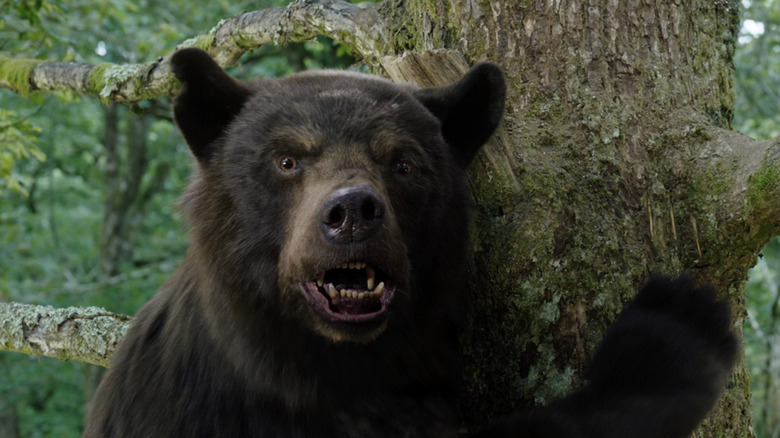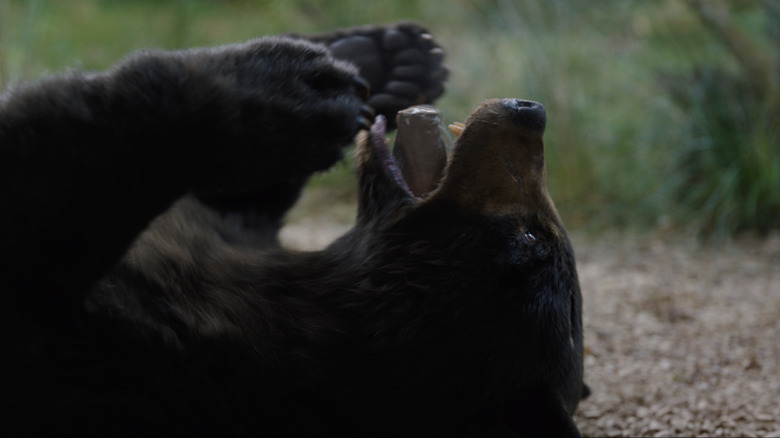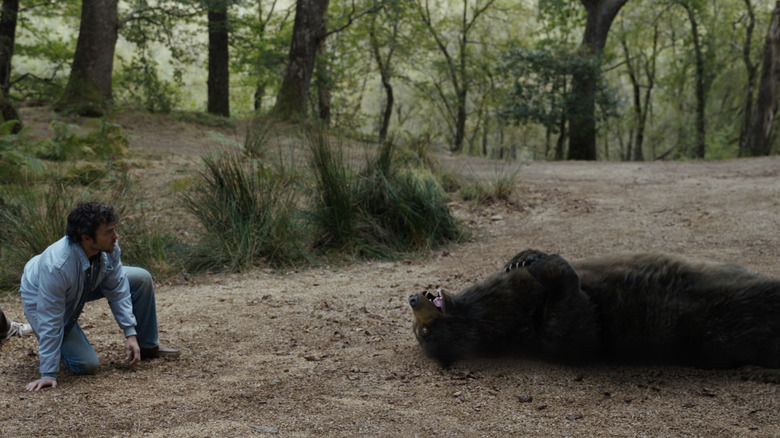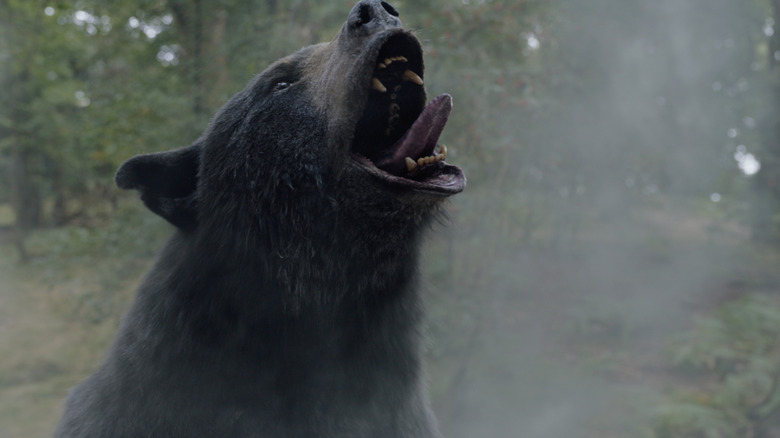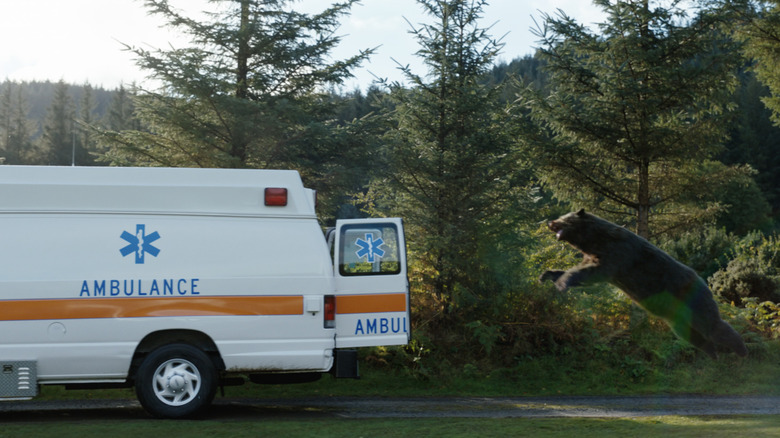Meet The Man Behind The Bear In Elizabeth Banks' Cocaine Bear [Exclusive Interview]
If you've seen anything about "Cocaine Bear," then you've been introduced to Cokey, the titular ursine entity that stumbles across a brick of cocaine in the woods and promptly goes on a killing spree in search of one more fix. As producers Lord and Miller told me in my interview with them, not only did no real-life bears do cocaine on set, but no real-life bears were involved at all. Cokey is a creation of Wētā FX, and while her distinct look comes from the artists there, she was also represented on set by motion capture performer Allan Henry, a veteran of movies like "Avengers: Endgame," "Jungle Book," and the "Planet of the Apes" trilogy.
I sought an interview with Henry after seeing the film and talking with Lord and Miller as well as Keri Russell about what they witnessed on the set. "He's on stilts on his arms, doing the bear movements and the whole bodywork for part of it," Russell told me, and I couldn't help but be intrigued.
Read on for my full interview with Henry, where we not only talk all things "Cocaine Bear," but about his other motion capture projects as well.
Note: This interview has been lightly edited for clarity and brevity.
'She would give me notes, just like she gave any other performer'
I know you've done similar things in other movies as well. How did "Cocaine Bear" compare to, say, a Marvel film?
This was a project that required a creature performance that's based on a creature we all know, a creature that is very recognizable and is an animal, whereas previous films, there have been certain levels of humanity in those characters.
Especially on films like the "Apes" trilogy or "Godzilla vs. Kong," there's something more human about those characters because of their enhanced intelligence and their greater experience, whereas Cokey is just a bear. Well, I shouldn't say just a bear. Cokey is a bear. The challenge was trying to move as close as I could to how a bear would move, the pace that a bear would take, the way that a bear would breathe and explore the environment around them.
Did you look to any other bears for inspiration in cinema, like "Semi-Pro" or "The Revenant"?
Yeah, I looked at bears that have been in media, like the bear from "The Revenant." I worked on "The Jungle Book" — at Weta, we did some stuff, so I looked at what we had done with Baloo for those sequences. But a lot of it was nature documentaries and CCTV footage and camera footage of people who were like, "There's a bear in my backyard tearing up my car."
When I was talking with Keri, she mentioned one of her memories from set was she would be acting against the bear — I'm assuming you — but then director Elizabeth Banks would just be yelling in a megaphone what was happening. I'd love to hear about your experience on set and how much leeway you had to emote the bear as you liked versus getting direction?
A lot of my interaction with Elizabeth, especially when it came to the bear interacting with the actors, was she would give me an outline of what the scene was trying to accomplish, what the other performers had to do, and a general idea of where and how the bear moves or where it goes to — it goes to that tree, and then it moves by that rock and then it goes through that bush.
Then she would leave it to me to explore my way through it, and we'd do a couple of rehearsals, and then she would give me notes, just like she gave any other performer, which is, "Maybe a little bit quicker, a bit faster for the camera move," or, "Scare the kids a bit more," or, "Don't scare the kids as much this time."
It was a lot of back and forth and her yelling at a megaphone, being just like, "Run over there!" and "Grab the thing!" and "Oh my god, the bear's coming!" And I'll be like, "Oh, that's my cue."
'How are you doing down there, buddy?'
Can you talk about the gear you wore on set? Because the only visual I've gotten is hand stilts, and I don't even know what that means, exactly.
So funnily enough, there's a hilarious photo on Instagram that Alden [Ehrenreich] posted where he took some behind the scenes photos of us when we were on set. And you can see the gear that I have. Literally, the arm extensions are similar to when someone injures themself, you see the crutches that they hobble around on. It's basically that, but in an aluminum form.
There's a ring that supports your forearm and then rods that come down the sides and there's a hand grip so I can hold onto it. And then that extends even further to essentially a foot or a prosthetic, like a rubber ball or something. It means that the length of my arm is now half a meter longer.
And then I have a helmet, very similar to the camera rigs we would use normally in performance capture to capture facial performance. And it has aluminum bars coming out, which have a silicone bear snout and mouth with little ping pong balls for eyes so that I can manipulate it and move it from my neck. And when Cokey interacts with the environment or with other actors, I can nuzzle them and move against them without causing any damage because the silicone is soft and moves the same way that skin would move.
I have to ask, the scene with Alden where the bear plops on top of him [as seen in the trailer] — did you actually plop on top of him?
Yeah, I lay on Alden, especially for that dancing scene, because he has to grab hold of the bear as well and kind of dance with the bear. To make sure that his arms were in the right kind of scale and proportion, they padded out the suit that I normally wore. I was normally wearing black spandex, so they padded it with these big chunks of foam to make me the width of a black bear.
For that scene, it was just me covered in foam and Lycra just lying down on top of Alden. And he was so into it. He's a professional and he's such a great sport. He had a stunt double, Ciaran [O'Grady], who was very, very talented. Ciaran and I showed Alden what was going to happen with the throwing and the dancing and the lying on top of, and we just said to Alden, "If you're comfortable, you can jump in if you want. If not, that's also fine."
And he was great. He was like, "Oh yeah, that seems fine. I feel comfortable doing this." And then I'd just lay on him and we'd chat in between takes and just be like, "How are you doing down there, buddy?" And he'd be like, "Yeah, I'm fine. It's all good. It's fine."
That's a lot of dedication to be laying on the ground covered in a silicone body suit.
Yeah, because I mean, I'm not a small dude either. I'm like 95 kilograms.
I don't know metric, but I'm sure that's more than —
Oh, of course. Yeah. [joking] It's like 700 pounds. [Editor's note: 95 kilograms is roughly 209 pounds.]
Did you have to do any work in post when you were back in New Zealand?
Yeah, we did a bit. But the majority of the work post-production-wise was just the artists at Weta. I mean, they're phenomenal. They're absolute magicians. They took everything that I did and they amplified it and enhanced it and just made it so good. I knew what the film was about, I was there making the film, but I was still so surprised by the result that they produced. It was absolutely magic.
'I've always been a thoroughly strange person'
I'd love also to hear a little bit more about how you got into doing this type of work. What was your first project with it and how did you get involved with this?
I've always been a thoroughly strange person, I think. I've been active and physical my whole life. When I was a kid, I did gymnastics and dance and martial arts and acrobatics. My friends and I would reenact scenes from our favorite action films. And then moving to the big city and going to drama school and doing the training, finding more ways to physically express myself and embody a character fully.
About 2007 was my first exposure to performance capture. This is way back when Weta were working on the "Halo" movie before that got canned. I just happened to do an audition for their motion capture team. That project didn't happen, but they kept me in mind. New Zealand is a small enough place that you can build networks very quickly and you figure out who's making what and who's working with who.
Then I started working on a few more gigs that were a bit more stunt-heavy. I think the first proper performance capture gig I got was probably working on "Tintin" in 2010. That was working for Weta for weeks doing performance capture. From there, they just kept asking me back to work on more projects.
What were you in "Tintin"?
There was a sequence where the characters are reminiscing about an ancient naval battle. And there was just me and about seven other people being Marines fighting pirates on big ships and swinging swords and jumping on ropes and flying around.
Oh, nice.
Then that grew into more background stuff and more background stuff. And then because a few of the characters weren't available because they had other commitments, they would ask me to come in and essentially be a digital double for them.
As you got more involved in this space, do you have any favorite creature performances or things that really inspired you or you took to heart for your own work?
I think the performances for me are almost like a bucket list of things nine-year-old Allan wanted to do. So it's like, "I want to be a monster." Tick. "I want to be a superhero." Tick. "I want to be a soldier running around shooting lasers." Yeah, tick. "I want to fly a spaceship." Tick.
It comes down to a series of performances that I really, really love and really enjoy. I loved working on "The BFG," and that was more in a capacity as a movement coach working with one of my mentors, Terry Notary, who is a genius. That was a great experience working in that capacity.
Then working with animation supervisors and directors for "Godzilla vs. Kong," which is great because working on the character of Kong is a really enjoyable character to play. I really like the idea of feeling like you're helpful and feeling like you are useful and you're contributing and helping to make this really, really great thing. It feels nice to feel like you are a part of it.
'On quadruped, once you get some speed up, you can go pretty quickly'
For my last question I want to go back to "Cocaine Bear." Is there any specific scene within the movie that was especially fun for you to perform?
I think there are so many. I had such a blast. Any scene working with Ray Liotta was pure gold. He was such a fantastic performer. He's an incredible actor and very respectful, but also he was a really sweet, lovely old man. Spending time chatting with him outside of shooting was great.
I think chasing the ambulance was fun. Scott Seiss and Kahyun Kim were hilarious. That whole sequence with the EMTs was a bonkers day. And Margo [Martindale] is comedy gold. Jesse Tyler Ferguson is comedy gold. And then you throw in Kahyun and Scott who are incredibly funny, we were laughing and joking, and it felt really, really great to go to work those days.
I have to follow up on that. I forgot about the ambulance scene. How could I? But I did. How fast can you run?
Fast. I mean, on quadruped, once you get some speed up, you can go pretty quickly, but not that fast. I don't know if we've actually tried to track it, because every time I'm running, it's usually the director just being like, "Run as fast as you can." I'm like, "Cool, okay, I guess I will." And then you just power on down the street.
There were times where they were like, "Oh, we could drive the ambulance a bit slower and have you catch up." But they could drive it at 10 kilometers an hour [6.2 miles per hour] or whatever it is and you'd still be pushing to catch up to it on all fours.
"Cocaine Bear" is in theaters now.
